tow VOLVO XC90 TWIN ENGINE 2018 User Guide
[x] Cancel search | Manufacturer: VOLVO, Model Year: 2018, Model line: XC90 TWIN ENGINE, Model: VOLVO XC90 TWIN ENGINE 2018Pages: 686, PDF Size: 17 MB
Page 169 of 686
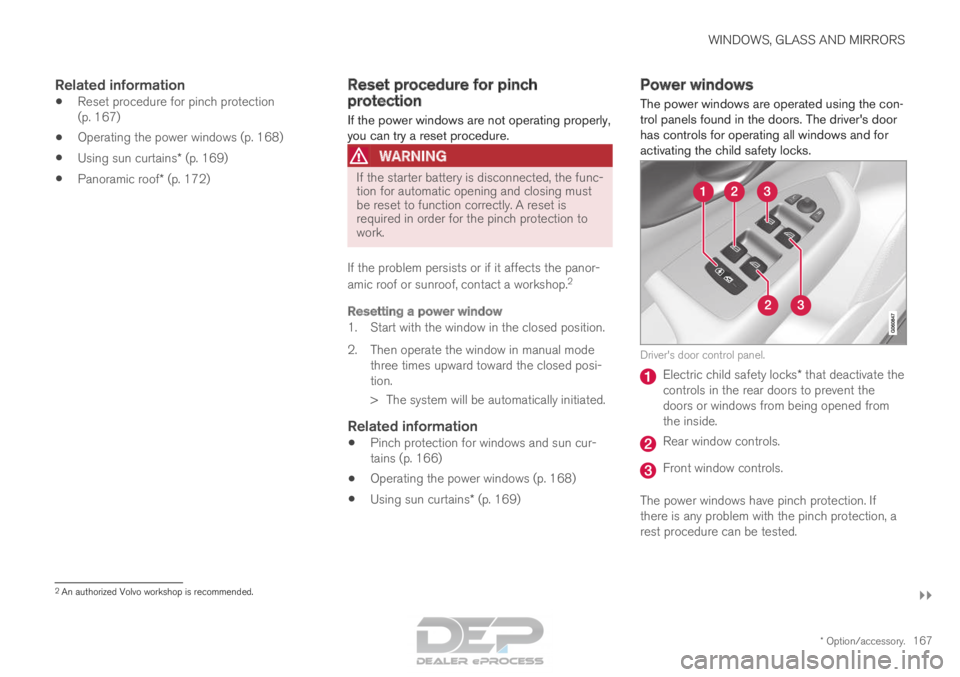
WINDOWS, GLASS AND MIRRORS
}}
* Option/accessory. 167
Related information
•Reset procedure for pinch protection
(p. 167)
• Operating the power windows (p. 168)
• Using sun curtains* (p. 169)
• Panoramic roof* (p. 172) Reset procedure for pinch
protection
If the power windows are not operating properly,
you can try a reset procedure.
WARNING If the starter battery is disconnected, the func-
tion for automatic opening and closing must
be reset to function correctly. A reset is
required in order for the pinch protection to
work.
If the problem persists or if it affects the panor-
amic roof or sunroof, contact a workshop. 2
Resetting a power window
1. Start with the window in the closed position.
2. Then operate the window in manual mode
three times upward toward the closed posi-
tion.
> The system will be automatically initiated.
Related information
• Pinch protection for windows and sun cur-
tains (p. 166)
• Operating the power windows (p. 168)
• Using sun curtains* (p. 169) Power windows
The power windows are operated using the con-
trol panels found in the doors. The driver's door
has controls for operating all windows and for
activating the child safety locks. Driver's door control panel.
Electric child safety locks* that deactivate the
controls in the rear doors to prevent the
doors or windows from being opened from
the inside. Rear window controls.
Front window controls.
The power windows have pinch protection. If
there is any problem with the pinch protection, a
rest procedure can be tested. 2
An authorized Volvo workshop is recommended.
Page 181 of 686

WINDOWS, GLASS AND MIRRORS
}}
* Option/accessory. 179
•
Windshield wipers in the service position
(p. 649)
• Replacing windshield wiper blades (p. 648)
• Changing rear window wipers (p. 647)
• Using the windshield wipers (p. 176) Using the windshield and headlight
washers
The windshield and headlight washers clean the
windshield and headlights. Use the right-side
steering wheel lever to start the windshield and
headlight washers.
Starting the windshield and headlight
washers Washing function, right-hand steering wheel lever.
–
Move the right-hand steering wheel lever
toward the steering wheel to start the wind-
shield and headlight washers.
>
After the lever is released, the wipers
make several extra sweeps.
CAUTION Avoid activating the washer system when it is
frozen or the fluid reservoir is empty. Other-
wise, there is a risk of damaging the pump.
Headlight washer*To save washer fluid, the headlights are washed
automatically according to a defined interval
when the headlights are on.
Reduced washingWhen there is about 1 liter (1 qt) of washer fluid
left in the reservoir and the
Washer fluid Level
low, refill message is displayed in the instrument
panel together with the symbol, the washer
fluid supply to the headlights is cut off. This is to
prioritize windshield cleaning and visibility
through it. The headlights are only washed if high
or low beam is on.
Related information
• Using the rain sensor (p. 177)
• Using automatic rear window wiping when
backing up (p. 181)
• Heated windshield washer nozzles* (p. 177)
• Using the rain sensor's memory function
(p. 178)
• Using the rear window wiper/washer
(p. 180)
• Filling washer fluid (p. 650)
Page 194 of 686

SEATS AND STEERING WHEEL
* Option/accessory.
192 •
Adjusting front seat side bolster settings*
(p. 190)
• Adjusting front seat lumbar support* (p. 190) Folding the second row backrests
The second row of seats has three individual
seating positions. The backrests can be folded
down separately.
WARNING •
Adjust the seat and ensure it locks into
position before driving. Use caution when
adjusting the seat. Uncontrolled or care-
less adjustments could lead to injury.
• Long objects must always be securely
tied down to help prevent injury or dam-
age in the event of sudden braking.
• Always turn off the engine and apply the
parking brake when loading or unloading
the vehicle.
• Put the gear selector in P to help prevent
the gear selector from being inadvertently
moved.
CAUTION When the backrest is folded down, make sure
there are no objects in the rear seat, and the
seat belts are not buckled. Otherwise there is
a risk of damage to the upholstery.
CAUTION The seat cushion of the integrated child
restraint* must be in the stowed position
before the center seat backrest can be folded
down.
The armrest* in the center seat must be
raised before the seat backrest is folded
down.
If the vehicle has private locking*, the ski
hatch must be closed before the seat back-
rest is folded down.
NOTE The front seats may need to be pushed for-
ward and/or the backrest adjusted so that the
rear seat backrests can be fully lowered.
The rear seats may also need to be moved
rearward.
The seats in the second row must be in the
upright position before they can be folded
down completely. They should not be folded
down when they are tilted forward to access
the third row of seats.
Page 211 of 686

CLIMATE CONTROL
209
Opening, closing and directing air
vents
Some of the air vents in the passenger compart-
ment can be individually opened, closed and
directed.
Misting can be eliminated by directing the outer
air vents towards the door windows.
Direct the outer air vents into the passenger
compartment to maintain a comfortable tempera-
ture in warm weather.
Opening and closing the air vents
Air vent thumb wheel
2
.
– Turn the thumb wheel to open/close the air-
flow from the vent.
The more white lines that are visible, the
stronger the airflow.
Directing air flow Airflow control
2
.
– Move the control from side to side or up and
down to direct airflow from the vent.
Related information
• Air distribution (p. 207)
• Adjusting air distribution (p. 208)
• Air distribution options (p. 210) 2
The illustration is generic - air vent design varies depending on its lo\
cation.
Page 267 of 686
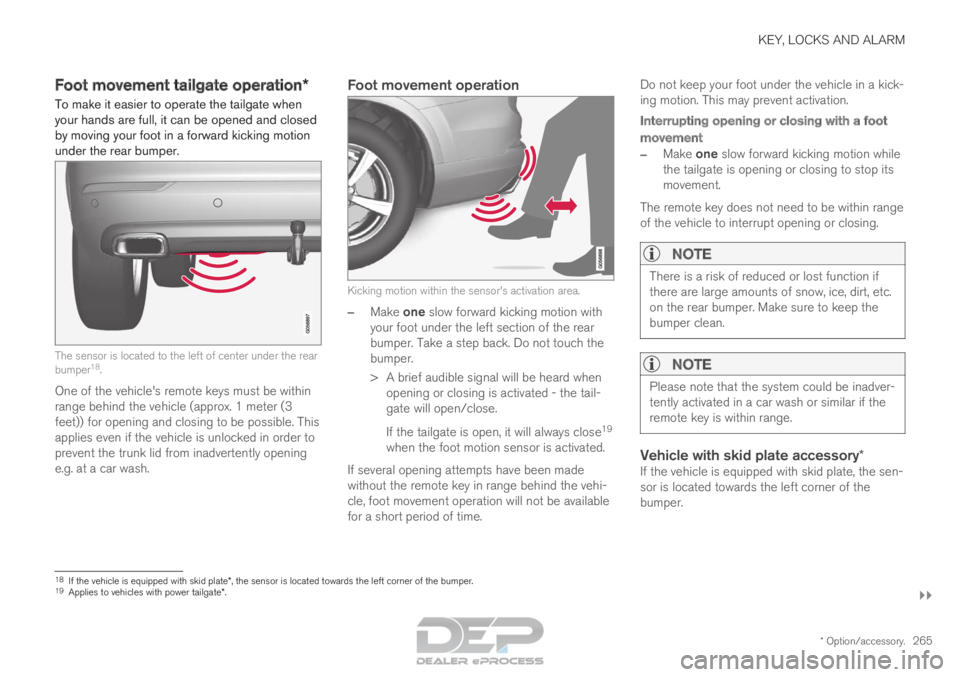
KEY, LOCKS AND ALARM
}}
* Option/accessory. 265
Foot movement tailgate operation*
To make it easier to operate the tailgate when
your hands are full, it can be opened and closed
by moving your foot in a forward kicking motion
under the rear bumper. The sensor is located to the left of center under the rear
bumper
18
.
One of the vehicle's remote keys must be within
range behind the vehicle (approx. 1 meter (3
feet)) for opening and closing to be possible. This
applies even if the vehicle is unlocked in order to
prevent the trunk lid from inadvertently opening
e.g. at a car wash.
Foot movement operation Kicking motion within the sensor's activation area.
–
Make one slow forward kicking motion with
your foot under the left section of the rear
bumper. Take a step back. Do not touch the
bumper.
>
A brief audible signal will be heard when
opening or closing is activated - the tail-
gate will open/close.
If the tailgate is open, it will always close 19
when the foot motion sensor is activated.
If several opening attempts have been made
without the remote key in range behind the vehi-
cle, foot movement operation will not be available
for a short period of time. Do not keep your foot under the vehicle in a kick-
ing motion. This may prevent activation.
Interrupting opening or closing with a foot
movement
– Make one slow forward kicking motion while
the tailgate is opening or closing to stop its
movement.
The remote key does not need to be within range
of the vehicle to interrupt opening or closing.
NOTE There is a risk of reduced or lost function if
there are large amounts of snow, ice, dirt, etc.
on the rear bumper. Make sure to keep the
bumper clean.
NOTE
Please note that the system could be inadver-
tently activated in a car wash or similar if the
remote key is within range.
Vehicle with skid plate accessory*If the vehicle is equipped with skid plate, the sen-
sor is located towards the left corner of the
bumper.
18
If the vehicle is equipped with skid plate*, the sensor is located towards the left corner of the bumper.
19 Applies to vehicles with power tailgate*.
Page 276 of 686
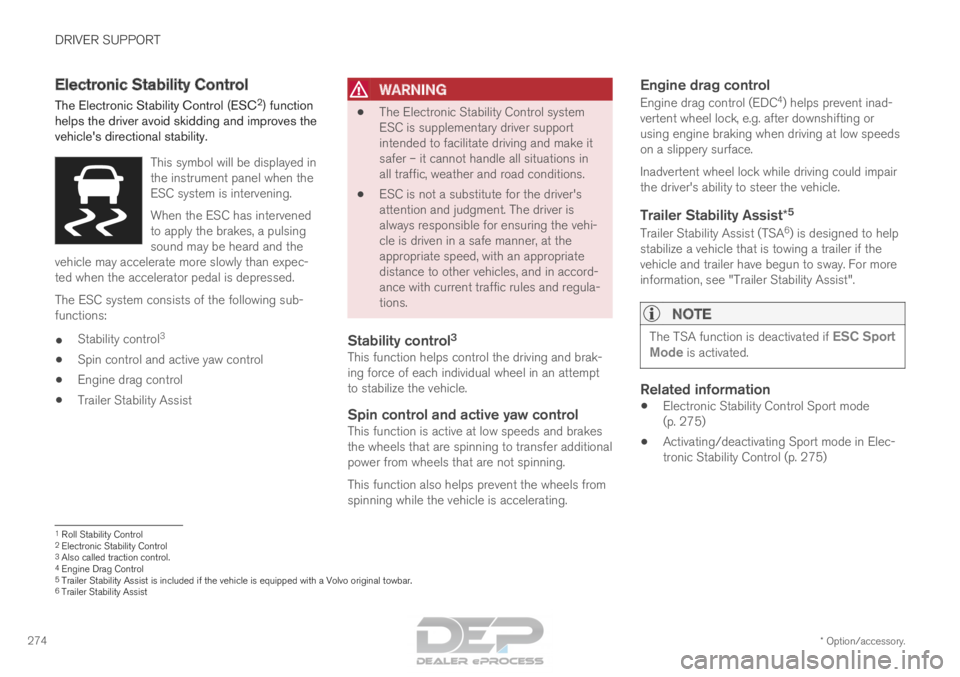
DRIVER SUPPORT
* Option/accessory.
274 Electronic Stability Control
The Electronic Stability Control (ESC 2
) function
helps the driver avoid skidding and improves the
vehicle's directional stability.
This symbol will be displayed in
the instrument panel when the
ESC system is intervening.
When the ESC has intervened
to apply the brakes, a pulsing
sound may be heard and the
vehicle may accelerate more slowly than expec-
ted when the accelerator pedal is depressed. The ESC system consists of the following sub-
functions:
•
Stability control 3
• Spin control and active yaw control
• Engine drag control
• Trailer Stability Assist
WARNING •
The Electronic Stability Control system
ESC is supplementary driver support
intended to facilitate driving and make it
safer – it cannot handle all situations in
all traffic, weather and road conditions.
• ESC is not a substitute for the driver's
attention and judgment. The driver is
always responsible for ensuring the vehi-
cle is driven in a safe manner, at the
appropriate speed, with an appropriate
distance to other vehicles, and in accord-
ance with current traffic rules and regula-
tions.
Stability control 3This function helps control the driving and brak-
ing force of each individual wheel in an attempt
to stabilize the vehicle.
Spin control and active yaw controlThis function is active at low speeds and brakes
the wheels that are spinning to transfer additional
power from wheels that are not spinning.
This function also helps prevent the wheels from
spinning while the vehicle is accelerating.
Engine drag control
Engine drag control (EDC
4
) helps prevent inad-
vertent wheel lock, e.g. after downshifting or
using engine braking when driving at low speeds
on a slippery surface.
Inadvertent wheel lock while driving could impair
the driver's ability to steer the vehicle.
Trailer Stability Assist* 5
Trailer Stability Assist (TSA
6
) is designed to help
stabilize a vehicle that is towing a trailer if the
vehicle and trailer have begun to sway. For more
information, see "Trailer Stability Assist".
NOTE The TSA function is deactivated if
ESC Sport
Mode is activated.
Related information
• Electronic Stability Control Sport mode
(p. 275)
• Activating/deactivating Sport mode in Elec-
tronic Stability Control (p. 275) 1
Roll Stability Control
2 Electronic Stability Control
3 Also called traction control.
4 Engine Drag Control
5Trailer Stability Assist is included if the vehicle is equipped with a V\
olvo original towbar.6 Trailer Stability Assist
Page 306 of 686

||DRIVER SUPPORT
* Option/accessory.
304 To reactivate ACC from standby mode:
– Press the button on the steering wheel
(1).
>
Speed will be set to the most recently
stored speed.
WARNING A noticeable increase in speed may follow
when the speed is resumed with the
steering wheel button.
Related information
•
Adaptive Cruise Control* (p. 295) Passing assistance with Adaptive
Cruise Control
Adaptive Cruise Control (ACC
51
) can assist the
driver when passing other vehicles.
How passing assistance worksWhen ACC is following another vehicle and you
indicate that you intend to pass that vehicle by
using the turn signal 52
, Adaptive Cruise Control
will begin accelerating toward the vehicle ahead
before your vehicle has moved into the passing
lane.
The function will then delay a speed reduction to
avoid early braking as your vehicle approaches a
slower-moving vehicle.
The function remains active until your vehicle has
passed the other vehicle.
WARNING Please note that this function can be acti-
vated in more situations than just passing
another vehicle, such as when a direction indi-
cator is used to indicate a lane change or
before exiting to another road – the vehicle
will then briefly accelerate.
Related information
•
Adaptive Cruise Control* (p. 295) Starting passing assistance with
Adaptive Cruise Control
Requirements for passing assistanceIn order to activate passing assistance:
• your vehicle must be following a vehicle
ahead (target vehicle)
• your vehicle's current speed must be
at least 70 km/h (43 mph)
• the set speed for ACC must be high
enough to safely pass another vehicle.
Starting parking assistanceTo start passing assistance:
–
Turn on the left turn signal.
>
Passing assistance will start.
Related information
• Adaptive Cruise Control* (p. 295) 51
Adaptive Cruise Control
52 Only the left-hand turn signal for left-hand drive vehicles, or right-ha\
nd turn signal for right-hand drive vehicles.
Page 309 of 686
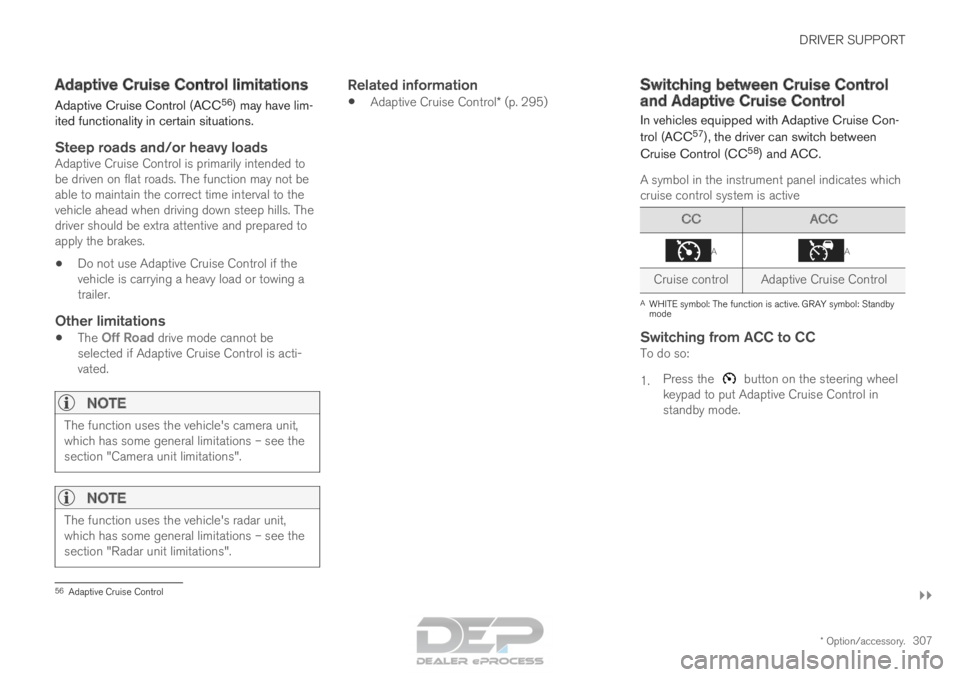
DRIVER SUPPORT
}}
* Option/accessory. 307
Adaptive Cruise Control limitations
Adaptive Cruise Control (ACC 56
) may have lim-
ited functionality in certain situations.
Steep roads and/or heavy loadsAdaptive Cruise Control is primarily intended to
be driven on flat roads. The function may not be
able to maintain the correct time interval to the
vehicle ahead when driving down steep hills. The
driver should be extra attentive and prepared to
apply the brakes.
• Do not use Adaptive Cruise Control if the
vehicle is carrying a heavy load or towing a
trailer.
Other limitations
•
The
Off Road drive mode cannot be
selected if Adaptive Cruise Control is acti-
vated.
NOTE The function uses the vehicle's camera unit,
which has some general limitations – see the
section "Camera unit limitations".
NOTE
The function uses the vehicle's radar unit,
which has some general limitations – see the
section "Radar unit limitations".
Related information
•
Adaptive Cruise Control* (p. 295) Switching between Cruise Control
and Adaptive Cruise Control
In vehicles equipped with Adaptive Cruise Con-
trol (ACC 57
), the driver can switch between
Cruise Control (CC 58
) and ACC.
A symbol in the instrument panel indicates which
cruise control system is active CC
ACC A A
Cruise control
Adaptive Cruise Control A
WHITE symbol: The function is active. GRAY symbol: Standby
mode
Switching from ACC to CCTo do so:
1. Press the button on the steering wheel
keypad to put Adaptive Cruise Control in
standby mode. 56
Adaptive Cruise Control
Page 315 of 686

DRIVER SUPPORT
}}
313
When the vehicle is approaching an off-ramp or a
fork in the road, the driver should steer toward
the desired lane to indicate to Pilot Assist the
desired direction of travel.
Pilot Assist strives to keep the vehicle
in the center of the lane
When Pilot Assist provides steering assistance, it
strives to position the vehicle in the center of the
lane between the lane markings. For the smooth-
est driving experience possible, the driver should
permit the vehicle to find the optimal positioning.
The driver should check that the vehicle is posi-
tioned safely in the lane and can always adjust
the vehicle's position by applying more force to
the steering wheel.
If Pilot Assist does not position the vehicle appro-
priately in the lane, the driver should turn off Pilot
Assist or switch to Adaptive Cruise Control.
Overview
Controls Function buttons and symbols
62
. : Activates Pilot Assist from standby
mode and resumes the set speed and time
interval : Increases the set speed
: From standby mode - activates Pilot
Assist and sets the current speed : From active mode - deactivates/puts
Pilot Assist in standby mode ◀: Switches from Pilot Assist to Adaptive
Cruise Control
: Reduces the set speed Increases the time interval to the vehicle
ahead
▶: Switches from Adaptive Cruise Control to
Pilot Assist
Reduces the time interval to the vehicle
ahead
Function symbol
Symbols for target vehicle and distance to
the vehicle ahead
Symbol for activated/deactivated steering
assistance
62
Note: This illustration is general and details may vary depending on mod\
el.
Page 323 of 686
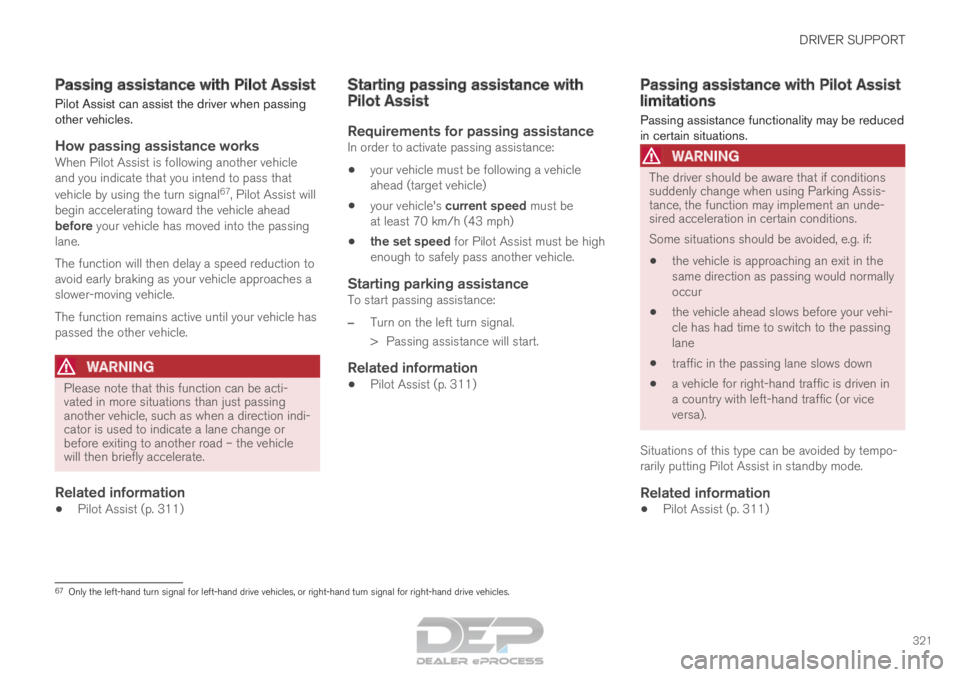
DRIVER SUPPORT
321
Passing assistance with Pilot Assist
Pilot Assist can assist the driver when passing
other vehicles.
How passing assistance worksWhen Pilot Assist is following another vehicle
and you indicate that you intend to pass that
vehicle by using the turn signal 67
, Pilot Assist will
begin accelerating toward the vehicle ahead
before your vehicle has moved into the passing
lane.
The function will then delay a speed reduction to
avoid early braking as your vehicle approaches a
slower-moving vehicle.
The function remains active until your vehicle has
passed the other vehicle.
WARNING Please note that this function can be acti-
vated in more situations than just passing
another vehicle, such as when a direction indi-
cator is used to indicate a lane change or
before exiting to another road – the vehicle
will then briefly accelerate.
Related information
•
Pilot Assist (p. 311) Starting passing assistance with
Pilot Assist
Requirements for passing assistanceIn order to activate passing assistance:
• your vehicle must be following a vehicle
ahead (target vehicle)
• your vehicle's current speed must be
at least 70 km/h (43 mph)
• the set speed for Pilot Assist must be high
enough to safely pass another vehicle.
Starting parking assistanceTo start passing assistance:
–
Turn on the left turn signal.
>
Passing assistance will start.
Related information
• Pilot Assist (p. 311) Passing assistance with Pilot Assist
limitations
Passing assistance functionality may be reduced
in certain situations.
WARNING The driver should be aware that if conditions
suddenly change when using Parking Assis-
tance, the function may implement an unde-
sired acceleration in certain conditions.
Some situations should be avoided, e.g. if:
•
the vehicle is approaching an exit in the
same direction as passing would normally
occur
• the vehicle ahead slows before your vehi-
cle has had time to switch to the passing
lane
• traffic in the passing lane slows down
• a vehicle for right-hand traffic is driven in
a country with left-hand traffic (or vice
versa).
Situations of this type can be avoided by tempo-
rarily putting Pilot Assist in standby mode.
Related information
• Pilot Assist (p. 311) 67
Only the left-hand turn signal for left-hand drive vehicles, or right-ha\
nd turn signal for right-hand drive vehicles.